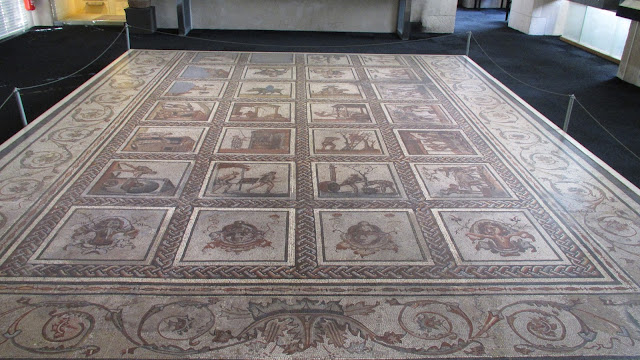Today we took the train to the Musée d’Archéologie Nationale. France’s national archaeology museum, is housed in what was once a royal palace – the Château de Saint-Germain-en-Laye. In the 1860s Napoleon III had the castle restored to house the nation’s archaeology collections. Today, the museum has a vast collection of artifacts from all over the country representing all periods in prehistory, from the earliest Paleolithic to the early Medieval.
It was around 1122 that Louis VI, “Louis the Fat”, had a fortified castle, known as the “Grand Châtelet”, built on the Laye plateau, then covered in forest. Between1230 and 1238, he had the chapel erected, separate from the other buildings, and the entire complex was surrounded by a defensive wall.
In 1337, France went to war with England, which laid claim to the throne of Philippe VI of Valois. The troops of the Black Prince, son of the English king, burned down the village that had gradually grown up and then the castle itself in 1346.
The château, although in a very poor condition, was classified as a historic monument on 8 April 1863. Renovation works were entrusted to the architect Eugene Millet, a pupil of Viollet-le-Duc, and continued, under Laffolye and Daumet until 1907. The transformation of the château into a museum enabled this historic monument, in poor condition after all its changes of use, to be protected. The interior was just a maze of cells, corridors, false floors and partition walls, reducing the space in the rooms and damaging the floors with their weight. Outside, the château had been demolished in parts and was covered with a blackish plaster.
It was around 1122 that Louis VI, “Louis the Fat”, had a fortified castle, known as the “Grand Châtelet”, built on the Laye plateau, then covered in forest. Between1230 and 1238, he had the chapel erected, separate from the other buildings, and the entire complex was surrounded by a defensive wall.
In 1337, France went to war with England, which laid claim to the throne of Philippe VI of Valois. The troops of the Black Prince, son of the English king, burned down the village that had gradually grown up and then the castle itself in 1346.
The château, although in a very poor condition, was classified as a historic monument on 8 April 1863. Renovation works were entrusted to the architect Eugene Millet, a pupil of Viollet-le-Duc, and continued, under Laffolye and Daumet until 1907. The transformation of the château into a museum enabled this historic monument, in poor condition after all its changes of use, to be protected. The interior was just a maze of cells, corridors, false floors and partition walls, reducing the space in the rooms and damaging the floors with their weight. Outside, the château had been demolished in parts and was covered with a blackish plaster.
The chapel, such a shame that it no longer has its beautiful rose window.
Female Vulva
Ivory Molding
The Musée d’Archéologie Nationale is where 100 odd Venus objects are held, Venus de Sireuil, The Venus of Brassempouy, Venus de Tursac, The Hermaphrodite, the Losange Venus and the Polichinelle Venus just to name some.
The Venus figurines are a term given to a collection of prehistoric statuettes of women made during the Paleolithic Period, mostly found in Europe, but with finds as far as Siberia. To date, more than 200 of the figurines have been found, all of whom are portrayed with similar physical attributes, including curvaceous bodies with large breasts, bottoms, abdomen, hips, and thighs, and usually tapered at the top and bottom. The heads are often of relatively small size and devoid of detail, and most are missing hands and feet. Some appear to represent pregnant women, while others show no such signs.
The Paleolithic period lasted from around 30,000 BC to 10,000 BC and is characterised by the emergence of human creativity. Man-made artifacts from this period show the very earliest signs of workmanship, from small personal adornments and cave paintings to the prevalent Venus figurines, which represent the earliest known works of figurative art.
The ivory figurine of the Venus of Brassempouy, I believe the Museum’s most prized possession.
The Lady of Beaupréau
Isis and Serapis
Mosaic called the seasons (Rhone)
I just loved this display showing the mold used to form the little statuettes
Wooden Dice nothing much changes over time.
Chatelaine with a triscele pattern using snakes.
A model of the Temple of Vesta from Rome
A model of the Temple of Vesta from Tivoli
A model of the Temple of Manly Fortune from Rome
A repica of the cauldron of Gundestrup, a cauldron dating from the 2nd century BC. J.-C. found in 1891 in a peat bog of Jutland in Denmark . It consists of the assembly of 13 silver plates, (12 richly decorated by hammering and a circular constituting the base and the bottom), and measures 42 cm . High for a diameter of 69 cm.
This cauldron is traversed by many motifs illustrating Celtic mythology , such as a representation of Cernunnos , another of Taranis , another of a god or a giant plunging dead warriors into a cauldron in order to resurrect them . In Celtic mythology, the "magic" cauldron can, according to legends, give food to a thousand men, such as the Dagda cauldron of abundance, or else to give universal knowledge to those who taste their contents or Still to resuscitate the dead. These virtues are, moreover, to be compared with those of beneficial sources.
This beautiful Tambour a small drum was so impressive.
Then this ceremonial drum really caught my eye.
The Goddess Venus
The Goddess Cybele
The Goddess Minerva




















































No comments:
Post a Comment